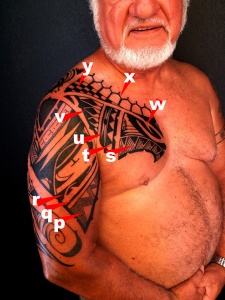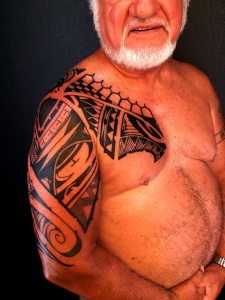Aloha!
I did this piece over the course of two days last week and had a blast! The client was a gentleman from Hilo who was looking for something to speak of his time in the military, his ties to his ancestors and also to show familial ties. It was also important that the tattoo incorporate protection as well as warrior motifs.
He came to me already having researched his family name and discovered that he had an ancestor that was a kumu lua (teacher in the art of Hawaiian hand to hand combat) who had taught skills to ali’i on Kauai during the time of Kamehameha I. He was also a pilot in the Vietnam war and also flew search and rescue with the fire department here in West Hawaii and also created the protocols for the now defunct marijuana eradication program, Green Harvest.
He wanted to tell his story of a warrior, of being descended from warriors and also to pay homage to his family. This piece was an awesome undertaking as I tried to combine all of these elements to create a cohesive piece. I had a blast working with the client and enjoyed immensely they time we spent over the two days that it took to complete.


Here is the breakdown of the symbols used:
a) maka [eye], this paka contains an eye; one looking forward, the other looking backward to protect from harm in either direction.
b) koru [unfurling fern head], symbolizing growth, life, breath, this gives intention to the piece behind it ‘c’.
c) na niho [teeth], there are 3 large niho, followed by 3 sets of 3 niho, the larger represent his 3 daughters and each set of 3 represent their respective children.
d) unahi [fish scales] love of the sea and for swiftness.
e) manu [bird] this theme is repeated throughout the piece and is a reference to his time as an airplane/helicopter pilot.
f) pepehipu [hammered tapa cloth] this is an armor analog for protection, it is inset with a row of niho at the end that is meant to protect the tattoo from harm.
g) ama kopeka/ahi [fire] this keeps bad spirits away and also acts to illuminate the path of the symbol behind it ‘i’.
h) pili niho [joined teeth] two joined teeth representing the union of him and his wife.
i) manu [bird] this theme is repeated throughout the piece and is a reference to his time as an airplane/helicopter pilot.
j) lei niho [garland of teeth] there are 2 rows, top and bottom, of teeth, each representing a year of marriage, 50 total, plus one to symbolize many more to come.
k) manu [bird] this theme is repeated throughout the piece and is a reference to his time as an airplane/helicopter pilot.
l) hoka [rays of the sun, rafter motif] this sort of symbol was one of many found carved or painted upon the rafter of a home or dwelling, it represents courage.
m) malu [protection] overlapping diamond shapes are meant to protect as armor.
n) lei-o-mano [string of shark teeth] this club-like weapon was used in hand to hand combat and in this instance is used to indicate his ancestral ties with a kumu lua that taught fighting techniques to ali’i on Kauai during the era of Kamehameha I.
o) ikeike [cyclophyllum barbatum] this hearty flowering shrub of the coffee family was known for its resistance, fortitude and toughness, its wood was also used to make weapons and tools.
p) a’aka hala/lauhala [Pandanus weave] this symbolizes the woven fronds of the hala tree and symbolizes family unity and armor.
q) la’au [club] this symbol represents a club used for combat and is a reference to part of his family name and ancestral past as kumu lua.
r) maka [eye], this paka contains an eye; one looking forward, the other looking backward to protect from harm in either direction.
symbols s,t,u,v,w are considered as one image, and that is the Spirit of War (SoW), which is a direct analog to his ancestor that was a kumu lua. It forms a head in profile, of the SoW.
s) pahiko a tuivi [fish net] this symbol makes up the mouth of the SoW and is intended to catch sin or protect from sin.
t) niho mano [shark teeth] this represents the first of his ‘aumakua, the shark, and makes up the part of the head portion of SoW.
u) naheka kai [sea snake] this represents his second aumakua, the sea snake, the triangle and two dots represent the pattern on the snake’s skin.
v) hulu pu’eo [owl feathers] this is his third aumakua, the owl.
w) mata hoata [all seeing eye] this makes pup the face of the Sow, it also has an ama kopeka, or flame on the top of its head.
x) ani ata [sky, heavens] this represents his ancestors as well as heaven and the horizon.
y) a’aka hala/lauhala [Pandanus weave] this symbolizes the woven fronds of the hala tree and symbolizes family unity and armor.
Mahalo for your time!
Roland


Looks Great !
Thank you!